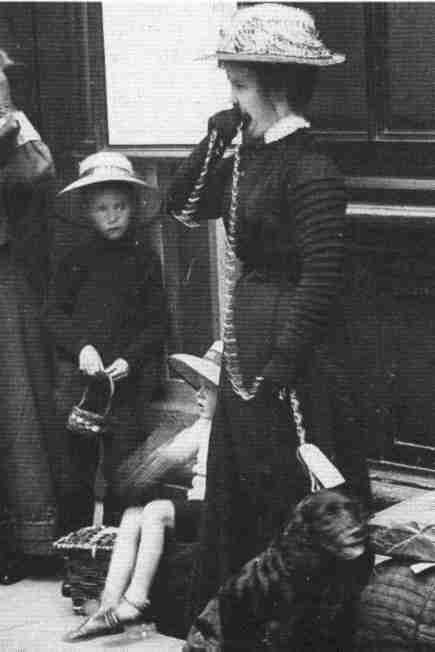
Traveling to Seaside Resorts: 20th Century England

Figure 1.--These English boys are waiting in the railroad station. Both wear broad-brimmed sailor hats. Note how they wear the turned-down brim style. The younger boy wears short pants without stockings and sandals. This is one of the earlier images I have seen of a boy wearing sandals.
|
By the turn of the century, a summer trip to the beach was a well etablished summer event. Most Brits would travel to the seaside resorts on the railroad. This continued until well after World War II (1939-45). It was only in the 1950s that it became increasingly common for average people to own cars and plan family vacations in them.
Beach Clothes
The following clothes were commonly seen at British beach resorts in the 20th century
Hats
The fashion staple of the late 19th century was sailaor cpa and hats. The wide-brimmed sailor hat was especially popular at the beach because the brim provuded shade. The wide brim hat was worn by increasingly younger boys by the 1910s. One popular style in the 1910s was to turn down the brim.
Sailor suits
Sailor suits were still widely worn by younger boys at the turn of the century. The style began to decline in popularity after World War I (1914-18).
Pants
English boys mostly wore kneepants and knickers with long stockings at the turn of the century. British boys began wearing short pants with kneesocks in the 1900s which were being popularized by the Scout movement. Younger boys by the 1910s might commonly wear short pants without socks at the beach. After World war I even older boys wore shorts without socks, usually with sandals.
Sandals
Sandals appeared early in the 20th century although I am not sure just when. Closed-toe sandals were very popular beach wear. Little boys might wear strap shoes while older boys would wear the "T" strap style and to a lesser extent the double strap style. They were called sand shoes.
Hosery
Children in the 19th century almost always wore long stockings, even in the summer or to the beach. Slowly socks replaced stockings in the 20th century and as the 20th century continued, increasingly boys would go without socks on the way and at the beach. They would no go barefoot, except at the beach itself. By the 190s sandals without socks would be worn while traveling to the beach.
Christopher Wagner
histclo@lycosmail.com
Navigate the Boys' Historical Clothing Web Site:
[Return to the English seaside page]
[Introduction]
[Chronology]
[Clothing styles]
[Biographies]
[Bibliographies]
[Literary]
[Countries]
[Contributions]
[Boys' Clothing Home]
Navigate the Boys' Historical Clothing Web Site:
[Sailor suits]
[Sailor hats]
[Buster Brown suits]
[Eton suits]
[Rompers]
[Tunics]
[Smocks]
[Pinafores]
Created: December 19, 1999
Last updated: December 19, 1999


